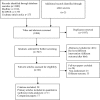The effectiveness of ω-3 polyunsaturated fatty acid interventions during pregnancy on obesity measures in the offspring: an up-to-date systematic review and meta-analysis
- PMID: 30251019
- PMCID: PMC6769093
- DOI: 10.1007/s00394-018-1824-9
The effectiveness of ω-3 polyunsaturated fatty acid interventions during pregnancy on obesity measures in the offspring: an up-to-date systematic review and meta-analysis
Abstract
Background: The potential role of ω-3 long chain polyunsaturated fatty acid (LCPUFA) supplementation during pregnancy on subsequent risk of obesity outcomes in the offspring is not clear and there is a need to synthesise this evidence.
Objective: A systematic review and meta-analysis of randomised controlled trials (RCTs), including the most recent studies, was conducted to assess the effectiveness of ω-3 LCPUFA interventions during pregnancy on obesity measures, e.g. BMI, body weight, fat mass in offspring.
Methods: Included RCTs had a minimum of 1-month follow-up post-partum. The search included CENTRAL, MEDLINE, SCOPUS, WHO's International Clinical Trials Reg., E-theses and Web of Science databases. Study quality was evaluated using the Cochrane Collaboration's risk of bias tool.
Results: Eleven RCTs, from ten unique trials, (3644 children) examined the effectiveness of ω-3 LCPUFA maternal supplementation during pregnancy on the development of obesity outcomes in offspring. There were heterogeneities between the trials in terms of their sample, type and duration of intervention and follow-up. Pooled estimates did not show an association between prenatal intake of fatty acids and obesity measures in offspring.
Conclusion: These results indicate that maternal supplementation with ω-3 LCPUFA during pregnancy does not have a beneficial effect on obesity risk. Due to the high heterogeneity between studies along with small sample sizes and high rates of attrition, the effects of ω-3 LCPUFA supplementation during pregnancy for prevention of childhood obesity in the long-term remains unclear. Large high-quality RCTs are needed that are designed specifically to examine the effect of prenatal intake of fatty acids for prevention of childhood obesity. There is also a need to determine specific sub-groups in the population that might get a greater benefit and whether different ω-3 LCPUFA, i.e. eicosapentaenoic (EPA) vs. docosahexanoic (DHA) acids might potentially have different effects.
Keywords: Adiposity; Body composition; Childhood obesity; Fatty acids; Fish oil; Growth; Infant’s growth; Meta-analysis; N-3 LCPUFA; Obesity; Systematic review.
Conflict of interest statement
On behalf of all authors, the corresponding author states that there is no conflict of interest.
Figures









Similar articles
-
ω-3 LCPUFA supplementation during pregnancy and risk of allergic outcomes or sensitization in offspring: A systematic review and meta-analysis.Ann Allergy Asthma Immunol. 2019 Mar;122(3):302-313.e2. doi: 10.1016/j.anai.2018.12.008. Epub 2018 Dec 12. Ann Allergy Asthma Immunol. 2019. PMID: 30552987
-
The Impact of Long-Chain Omega-3 Polyunsaturated Fatty Acid Supplementation in Pregnant Women Toward the Intelligence Status of Early Childhood: Protocol for a Systematic Review and Meta-Analysis.JMIR Res Protoc. 2025 Apr 17;14:e60417. doi: 10.2196/60417. JMIR Res Protoc. 2025. PMID: 40245394 Free PMC article.
-
Reduction of the n-6:n-3 long-chain PUFA ratio during pregnancy and lactation on offspring body composition: follow-up results from a randomized controlled trial up to 5 y of age.Am J Clin Nutr. 2016 Jun;103(6):1472-81. doi: 10.3945/ajcn.115.128520. Epub 2016 Apr 6. Am J Clin Nutr. 2016. PMID: 27053380 Clinical Trial.
-
Effects of maternal omega-3 fatty acids supplementation during pregnancy/lactation on body composition of the offspring: A systematic review and meta-analysis.Clin Nutr. 2018 Oct;37(5):1462-1473. doi: 10.1016/j.clnu.2017.08.002. Epub 2017 Aug 10. Clin Nutr. 2018. PMID: 28830700
-
ISSFAL statement number 7 - Omega-3 fatty acids during pregnancy to reduce preterm birth.Prostaglandins Leukot Essent Fatty Acids. 2022 Nov;186:102495. doi: 10.1016/j.plefa.2022.102495. Epub 2022 Sep 30. Prostaglandins Leukot Essent Fatty Acids. 2022. PMID: 36228573 Review.
Cited by
-
Association between maternal erythrocyte polyunsaturated fatty acid levels during pregnancy and offspring weight status: A birth cohort study.Front Nutr. 2022 Sep 29;9:978679. doi: 10.3389/fnut.2022.978679. eCollection 2022. Front Nutr. 2022. PMID: 36245520 Free PMC article.
-
Systematic Literature Review and Meta-Analysis of the Relationship Between Polyunsaturated and Trans Fatty Acids During Pregnancy and Offspring Weight Development.Front Nutr. 2021 Mar 25;8:625596. doi: 10.3389/fnut.2021.625596. eCollection 2021. Front Nutr. 2021. PMID: 33842522 Free PMC article.
-
Divergent Regulation of Myotube Formation and Gene Expression by E2 and EPA during In-Vitro Differentiation of C2C12 Myoblasts.Int J Mol Sci. 2020 Jan 23;21(3):745. doi: 10.3390/ijms21030745. Int J Mol Sci. 2020. PMID: 31979341 Free PMC article.
-
Adipose Tissue Development and Expansion from the Womb to Adolescence: An Overview.Nutrients. 2020 Sep 8;12(9):2735. doi: 10.3390/nu12092735. Nutrients. 2020. PMID: 32911676 Free PMC article. Review.
-
Total Fat and Fatty Acid Intake among 1-7-Year-Old Children from 33 Countries: Comparison with International Recommendations.Nutrients. 2021 Oct 9;13(10):3547. doi: 10.3390/nu13103547. Nutrients. 2021. PMID: 34684548 Free PMC article.
References
-
- European Association for the Study of Obesity . Obesity facts & figures obesity facts & figures: useful resources from the WHO Regional Office for Europe. Obesity facts & figures: World Health Organisation Fact sheet. Vienna: European Association for the Study of Obesity; 2015.
-
- Paulis WD, Silva S, Koes BW, Van Middelkoop M. Overweight and obesity are associated with musculoskeletal complaints as early as childhood: a systematic review. Obes Rev. 2014;15:52–67. - PubMed
-
- Barker DJ. Fetal nutrition and cardiovascular disease in later life. Br Med Bull. 1997;53(1):96–108. - PubMed
Publication types
MeSH terms
Substances
LinkOut - more resources
Full Text Sources
Other Literature Sources
Medical
Research Materials

